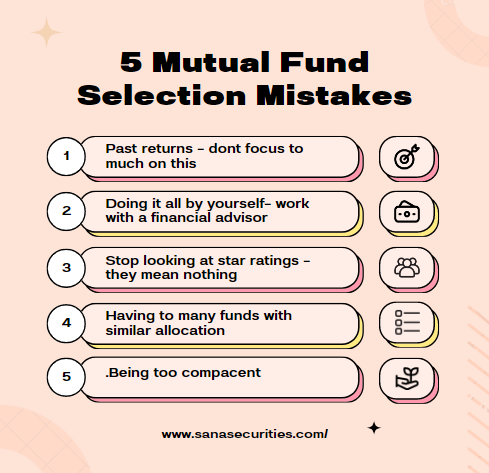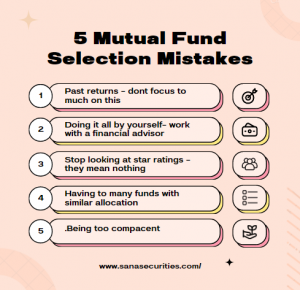Confused about how to go on with your mutual fund selection? Read on –
[I] Past returns: The number one mistake people make with their mutual fund selection process is to invest based on past returns. Often investors look at returns generated over the past 1–3-year period and invest on that basis.
However, all empirical evidence suggests that funds that outperform over one-, two- or three-year period(s) often give poor returns over the next few months and years. The reason is simple, massive outperformance over other funds is typically made in two cases. First, in the case of a thematic or sectoral fund when the sector in which the mutual fund invests outperforms due to external circumstances like favorable regulatory environment. Second, perhaps the fund was concentrated in one or two stocks which outperformed. Mostly, this is a temporary phenomenon.
Always look at five- or ten-year returns when investing for a longer term. If you ask me, it takes at least seven years for a full economic cycle to play out. If you are investing for 1-3 years, stick to debt mutual funds or fixed deposits.
[II] Doing it all by yourself – Here’s a story. One of my clients is a former fund manager. He was in the top management of a top 10 mutual fund company. I was fairly surprised the first time he called and asked me to manage his portfolio. Naturally, he knew all about mutual funds and expense ratios of different plans and did the exact same work for which he was hiring me. I enquired – “why do you want me to manage your portfolio?” He said, “I don’t want you to manage my portfolio, I just want to engage more minds with my investments”. This simple message has changed the way I invest and deal with money.
The job of a financial advisor is not to help you with your mutual fund selection process. In fact his/ her primary job is to be an emotion manager more than a fund manager. I meet with my relationship managers across fund houses and banks. They all tell me the same thing – investors in direct mutual funds churn (i.e., buy/ sell) their portfolios a lot. Investors who work with a financial advisor are stickier. They don’t change their allocation frequently and stay the course for a long term.
Wonder why?
It could be their financial advisor who stops them from churning in subtle ways. Or maybe they leave their investments for the advisor to manage. Or maybe the fact that they have another layer to convince before they make a buy/ sell decision stops them from acting. Not acting always makes more money over the long term. Whatever may the reason be, people working with an advisor mostly make a lot more money than investors who do it themselves. It is all about emotions! Of course, on paper, you may get convinced otherwise.
As an experiment, try putting 20% of your portfolio with a good financial advisor. After 5 years, see the difference in percentage terms between how the 80% managed by you performed vs the 20% managed by your advisor. In any event, the way the difference between expense ratios of direct and regular plans has gotten squeezed over the years, it hardly merits any advantage of choosing direct over regular plans.
[III] Star Ratings – First of all, a mutual fund must be at least 3 years old to get rated. So younger funds even from top fund houses will not have a star rating.
A more fun fact is that if you look at the top performing funds, you will notice a startling contrast. 5-star funds usually underperform 2-3 star funds. In fact, subconsciously I always try to avoid 5 start funds for you can almost be certain that they will underperform in the coming years.
Don’t believe me? Here are some facts –
- On a 5-year returns basis, 7 out of the top 10 best performing large cap funds are rated 3 star or below.
- On a 5 year returns basis, 8 out of the top 10 best performing mid cap funds are rated 4 star or below.
- On a 5-year returns basis, 9 out of the top 10 best performing small cap funds are rated 3 star or below.
The problem of 5 star rated funds underperforming is particularly glaring in case of mid and small cap funds for reasons I have mentioned here – See under Small Cap Fund – Tata Small Cap Fund.
[IV] Too many funds with similar allocation – Mutul fund selection is an art. I see many investors picking up funds with different fund houses but with very high allocation to the same set of stock(s). For example, holding a multi cap fund and a large cap fund both of which have a very high allocation to HDFC bank and Reliance Industries. This will make no sense.
There are many tools/ apps to check the stock-wise weightage of your portfolio across all the mutual funds that you are invested in. Use these tools!
[V] Being too Complacent – It is one thing to stay invested for a long term and quite another to simply ignore your portfolio. Keep your short and long term goals in mind and make sure to rebalnce your portfolio from time to time. Ask these questions at least once a year:
- Is your portfolio underperforming its benchmark? If so, why? It is OK if the underperfomance is on account of a justifiable reason. Fo example – value funds did not perform well between 2018-2020 but outperformed everything else between 2021-2023. If you had compared value funds to their underlying index (like large cap Nifty) between 2018-20, they would have shown underperfomnce albeit for a very justifiable reason.
- Is your mix between debt/ equity or equity/debt being maintained? Should you rebalce by making a switch between funds?
- Should you allocate some capital to a thematic fund?
- Most imprtantly – can you increase your monthly commitment? A 5-10% higher allocation to SIPs each year could double your returns in 8-12 years. Remember – Incresing your revenue stream compounds money faster than any other way known to mankind.
For a one on one consultation, write in to me at rajat@sanasecuritiescom
Good Luck!




“I just want to engage more minds with my investments” : this is really a new perspective that I have never heard before. It is indeed true that this method will significantly reduce the errors due to human biases towards investment, and will certainly help in achieving higher returns.
yes it does. but no one thinks of this. 5 sharp minds can amplify returns at least 3-5% year on year.